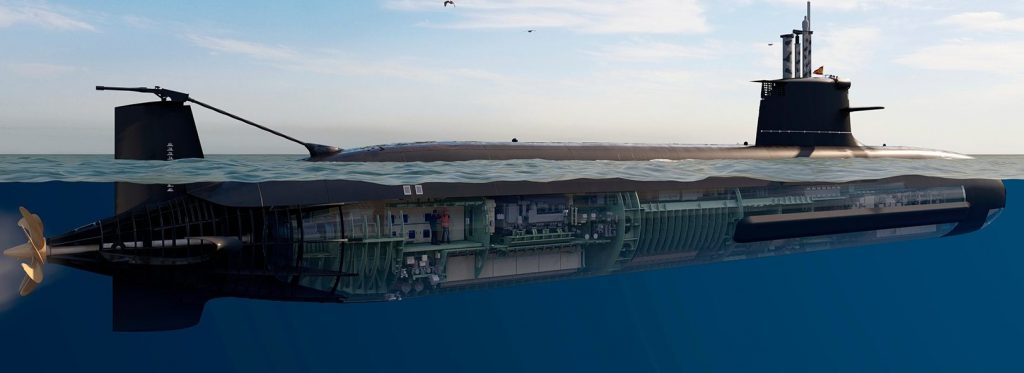After the French Naval Group, the Spanish Navantia proposed to help the Philippines Navy build a submarine fleet by giving S80 Isaac Peral class submarines with enhanced stealth and tactical capability. The extensive proposal includes training the crew and developing a submarine base at Ormoc, Leyte.
The Philippines is the only Southeast Asian country embroiled in a territorial dispute with China that doesn’t operate a submarine. As of 2012, Indonesia, Singapore, and Malaysia were already operating submarines, with Vietnam following suit. Even Myanmar has its submarines.
The EurAsian Times had earlier reported on the French Naval Group’s offer to build a Scorpene submarine for the Philippines Navy. The South Korean Hanwa Ocean is left to outline its proposal for the Philippines’ underwater arm.
The Spanish Navantia and French Naval Group’s proposals are similar in all aspects except for the location of the submarine base. The Naval Group has proposed the submarine base at Agila Subic.
The Philippines’ confrontation with China over the control of vast swathes of the South China Sea is fast becoming one of the conflict triggers in the region. China is becoming relentless in its aggression and Gray Zone operations in the region.
The state-owned Spanish company Navantia has submitted a US$1.7 billion offer to develop the country’s submarine force. The comprehensive offer includes delivery of two latest S80 Isaac Peral class submarines, extensive training of the crew and staff of the Philippines Navy, transfer of technology in submarine operation and maintenance, and helping submarines build a military hardware manufacturing capability.
Guillermo Zamarripa, key account commercial manager for Asia of the Commercial and Business Development Division of Navantia, said in a press briefing: “Navantia is offering a complete solution for supporting the Philippines’ new submarine force, with a revolutionary submarine concept, ensuring real interoperability and taking care of the necessities for training and administrative duties.”
Zamarripa added that locating the submarine base in the Central Philippines, particularly in Ormoc, is in sync with the government’s strategy of dispersing naval assets across the country for security and quick deployment to conduct their missions.
To sweeten the deal further, Navantia has offered the Spanish government’s sovereign guarantee of the loan equivalent to 100 percent of the final value of the contract. This means a concessional or lower interest on the loan, as Spain will carry the risk. Payment will begin only after the submarines are delivered, about seven to eight years after the proposed government-to-government contract is signed.
The S80s can engage in sea-to-land attacks, intelligence, surveillance and reconnaissance activities, and anti-surface and anti-submarine warfare. Just like other high-powered military assets, their primary purpose is deterrence.

Commodore Ajay Jay Singh, a retired submariner from the Indian Navy, told the EurAsian Times: “They (Filipinos) must counter the Chinese CG and maritime militia. An overtly hostile presence could lead to unintended consequences. A submarine capability will restrict Chinese options if they intend to use force to get their way in the disputed waters. Any augmentation of the SE Asian navies to counter the Chinese threat would be an effective deterrent.”
Stealth – Thy Name Is Isaac Peral
The Isaac Peral (S80 series) is one of the largest non-nuclear submarines in the world and has the unique feature of using a bioethanol fuel cell AIP (Air Independent Power) system, known as BEST (Bio-Ethanol Stealth Technology). It has advantages over other AIP systems.
Conventional submarines need to surface once in 24 hours to recharge their batteries being used with the diesel engines. This makes them vulnerable to detection and attack. The AIP system minimizes this exposure by recharging the batteries even while the submarine is submerged.

According to Navantia, BEST consists of a bioethanol reformer to produce hydrogen, which reacts with oxygen in a fuel cell, generating electricity. This system enables the vessel to extend its endurance, operating independently underwater for up to three weeks, which considerably reduces its detectability level. Also, ethanol is readily available. Other AIP submarines use hydrogen tanks.
The submarine has three primary weapons. These are the DM2A4 heavyweight torpedo, UGM-84 Sub-Harpoon anti-ship missile, and SAES seabed mines. It also can deploy the UGM-109 Tomahawk land attack cruise missile. This will place the Spanish Navy in an elite group of submarine operators with a ‘first night’ strategic strike capability.
The ‘first night’ strategic strike capability is unique among non-nuclear NATO submarines. It entails entering shallow waters and launching an attack from close to the enemy territory.
It is a highly automated submarine with a state-of-the-art platform control system developed by Navantia Sistemas. It can be operated by a limited crew (32 sailors and eight berths for additional embarked personnel). The S-80 class submarine can reach an underwater speed of over 19 knots and a maximum depth capacity of over 300 meters. It is approximately 80 meters long, 7 meters in diameter, and has a submerged displacement of 3,000 tons.
Scorpene Submarines Vs. S80 Series
Compared to Scorpene-class submarines, the S80 has a wider hull. The pressure hull diameter of S80 is 7.3 meters (24 ft) compared to 6.2 meters (20 ft) of Scorpene class submarines. This seemingly small difference is enough to allow for an extra deck level.
It also means that it carries the same number of torpedoes, but the torpedo room does not take up the entire height of the forward part of the submarine. S80’s length is also more at 80.8 meters (232 ft) than the 61.7 meters (202 ft) of Scorpene.
Another significant difference is that the S-80 is designed, from the start, as an AIP submarine. The Scorpene class submarines have developed AIP and are now retrofitting it. India purchased the Kalvari class variant of Scorpene and is retrofitting it with a local AIP system.
- Ritu Sharma has been a journalist for over a decade, writing on defense, foreign affairs, and nuclear technology.
- She can be reached at ritu.sharma (at) mail.com




